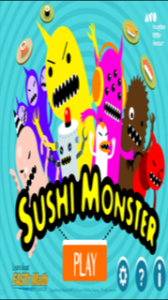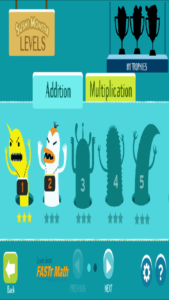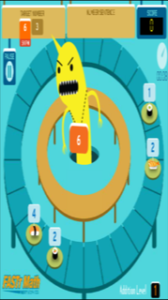Welcome back!

The application that I have chosen to individually evaluate is called Sushi Monster.
Sushi Monster is a math application that focuses on addition and multiplication using a series of levels. This application has the visual of a monster in the middle with a number tag on him and a conveyor belt with various numbers around him. The student is to tap on the various pieces of sushi to add or multiply to the number shown on the monster (and in the top left corner). There is a scoreboard in the top right corner for students to see how they are doing throughout the game, as well as a number sequence section in the top middle so that students can see what numbers they have chosen in a sequence. Under the scoreboard, there is also a stopwatch that shows students how long they have taken to complete the level (there is the option to remove the stopwatch in the settings menu).
Evaluate the application with respect to relative multimedia learning principles.
This application aligns with quite a few of the multimedia learning principles (Mayer, 2014). Some of the principles that it aligns with are the multimedia principle, split-attention principle, redundancy principle, signalling principle, and the learner control principle. Overall, the application appears to use a sufficient amount of the multimedia learning principles in a way that allows for students to be engaged in the material, but not overwhelmed by how much is going on.
Include your personal experiences and impressions while using the application from an instructors’ perspective.
While going through this application there are a variety of things included that I did like and some other things that I would have liked added.
When I first opened the application and hit play it takes me to a screen where I can either choose addition or multiplication. From here I can select level one and start playing. The act of getting to the actual gameplay was quite simple for me which I liked. Once you pass level 1 you can progress to level 2 and so on. I liked the feature of having the option of a timer for those students who will want to challenge themselves or for those who just want to practice in an untimed environment. I also liked how they had the animation of the monster eating the sushi and of the little character putting them onto the conveyor belt. There is also the option of having music and audio for any students that may want it.
A couple of things I would like added are an option for subtraction and division, more levels, and possibly audio of each number being said one it is tapped on.
An option that I thought about is for students who want to time themselves they could have a page where they could write the date, level, score, and time so they can see how much they improve throughout the year.
Overall, the app is very simple and straightforward to use and I could envision teachers using this for any students who are struggling with or would like to improve their addition and multiplication.


Evaluate the application using one or more multimedia and interactive learning tool evaluation rubrics.
I used the UWO rubric for my assessment of Sushi Monster. Overall, this application fits into the “works well section” of the rubric. A couple of areas for minor concern however are its lack of presence as a free desktop application and the lack of collaboration options for the application.
References:
Anstey, L., & Watson, G. (2018, September 18). A Rubric for Evaluating E-Learning Tools in Higher Education. Educause Review. https://er.educause.edu/articles/2018/9/a-rubric-for-evaluating-e-learning-tools-in-higher-education
Houghton Mifflin Harcourt. (2016). Sushi Monster. [Mobile application software].
Mayer, R. E. (Ed.). (2014). The Cambridge Handbook of Multimedia Learning (2nd ed.). Cambridge University Press. https://doi.org/10.1017/CBO9781139547369